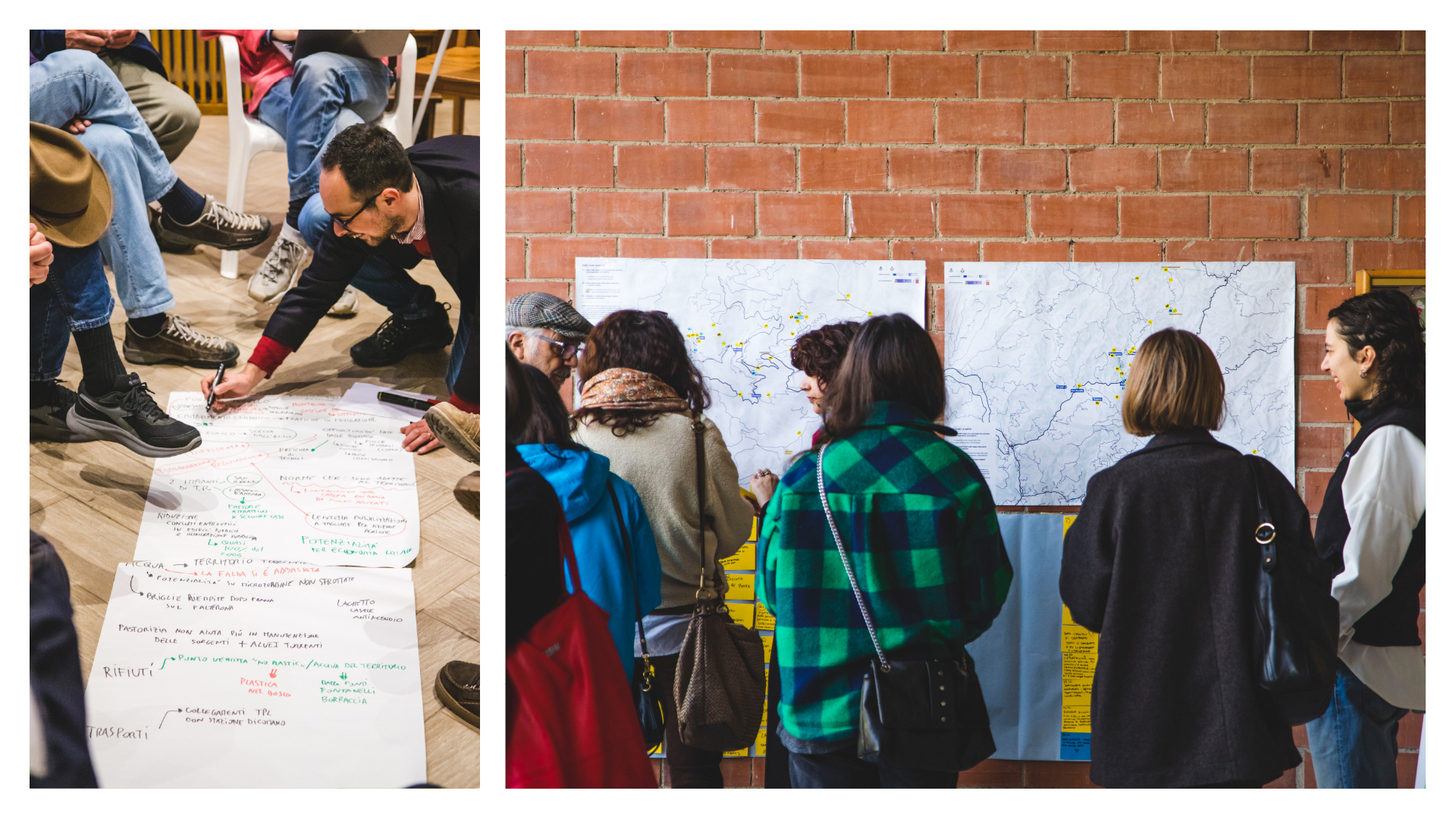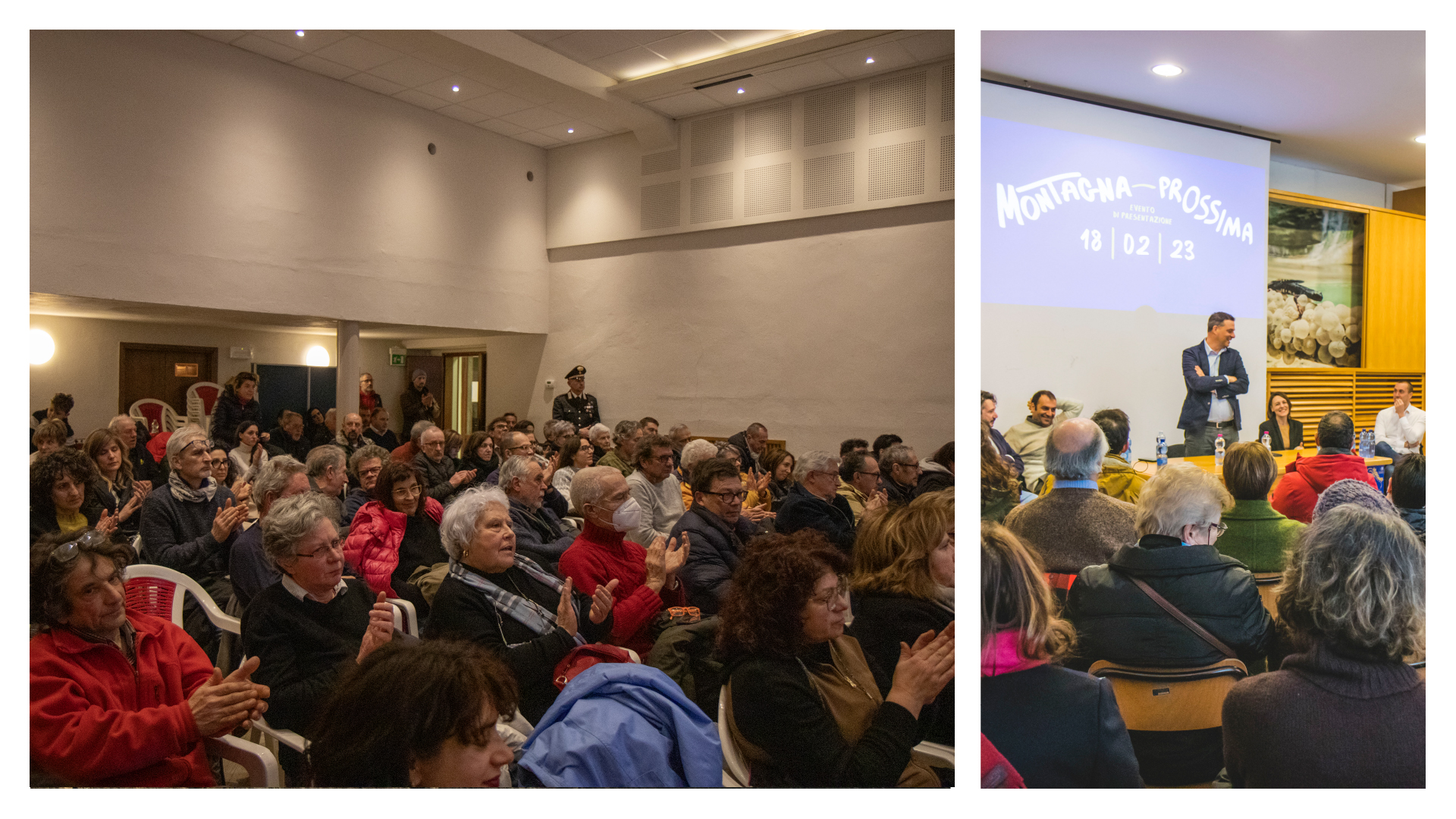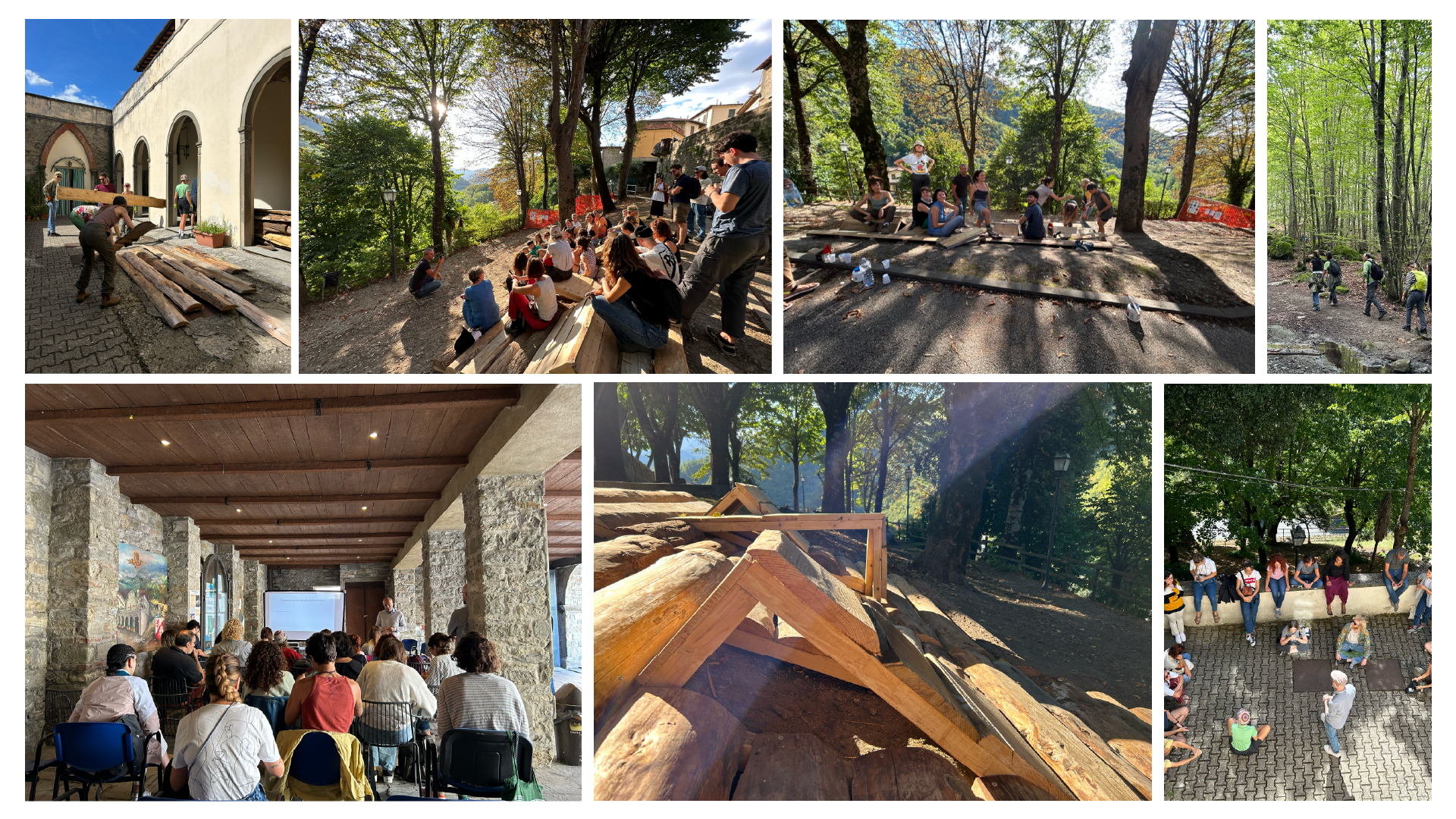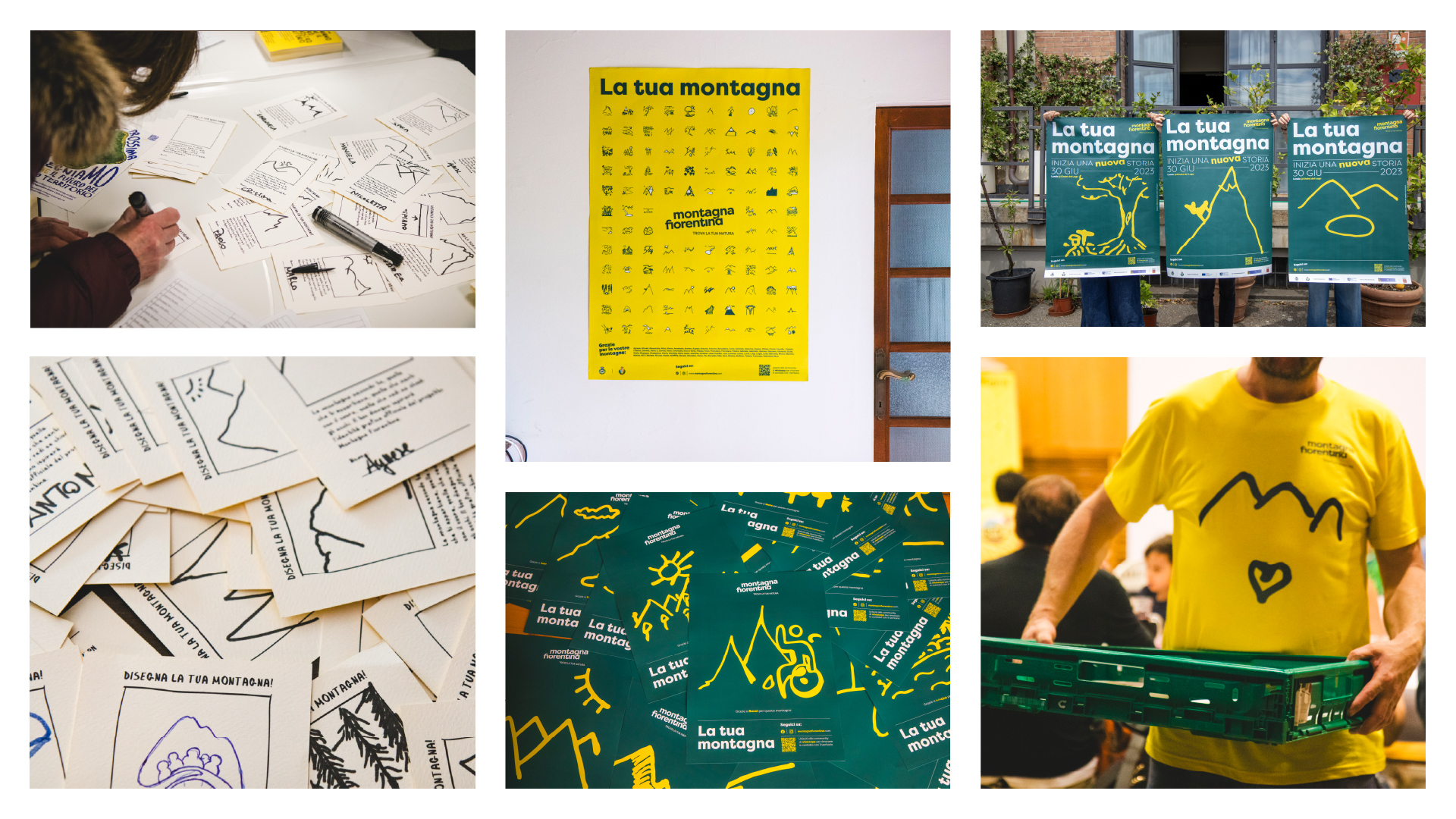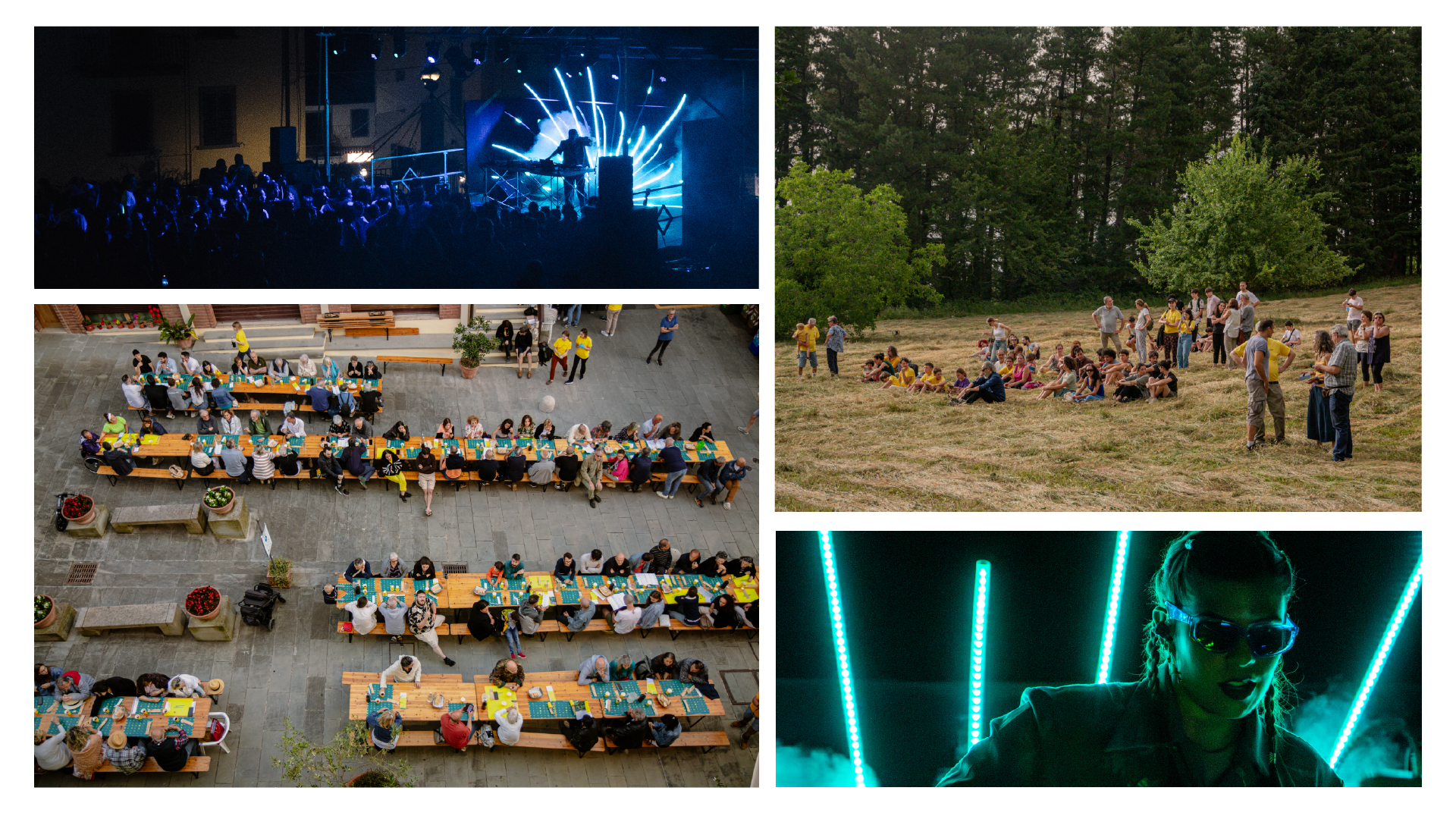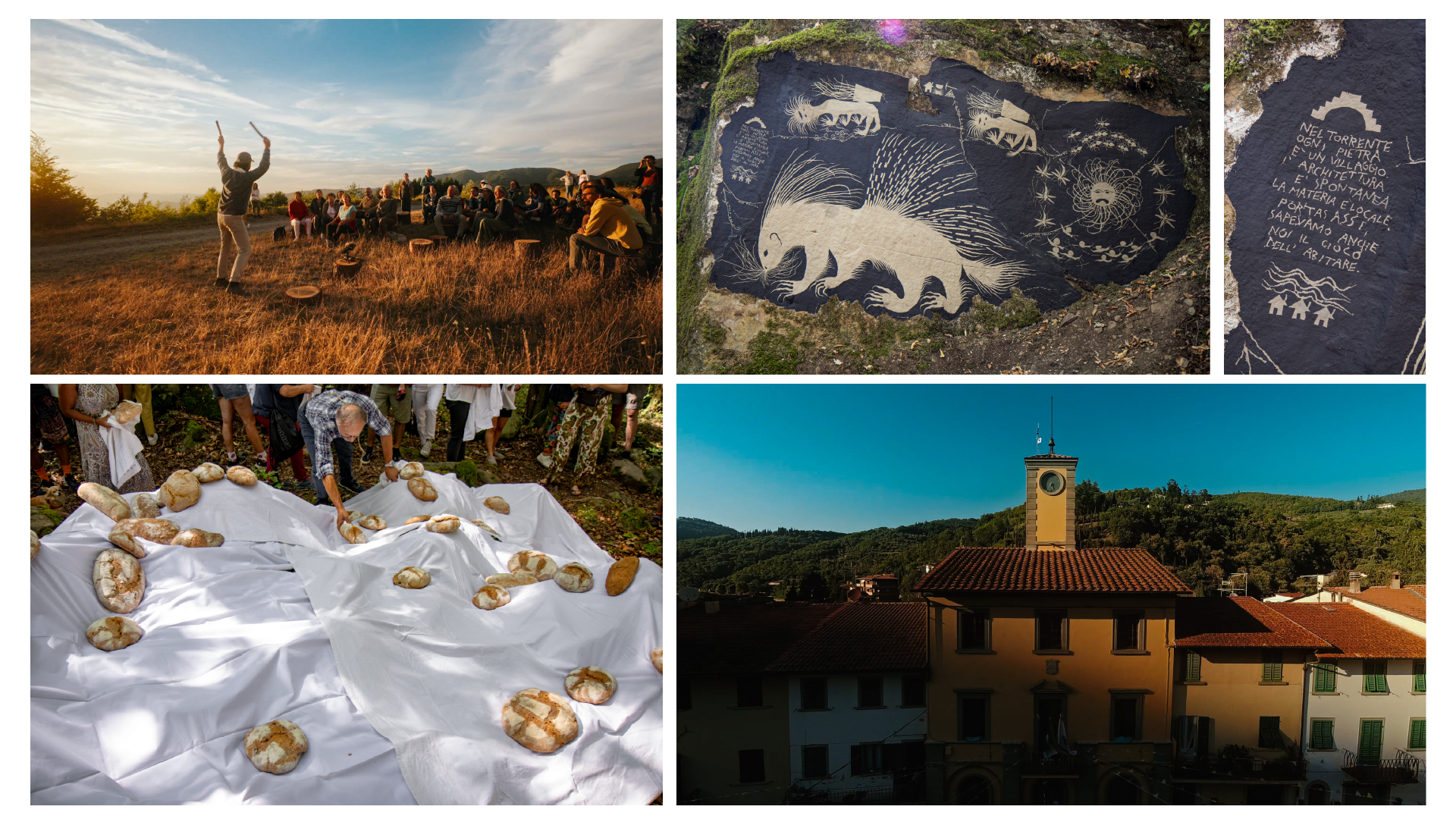Montagna Fiorentina
{Empty}
At the crossroads of Tuscany and Emilia-Romagna, Londa and San Godenzo, gateways to the Casentinesi Forests, face depopulation and weak tourism. A bold project with 12 initiatives — revitalizing key landmarks and launching community-driven programs—places art and culture at the core to boost sustainable tourism, accessibility, and innovation. Montagna Fiorentina becomes a hub of creativity and well-being, offering a model for inclusive, lasting governance in small municipalities.
Italy
{Empty}
Prototype level
Yes
Yes
Yes
Yes
ERDF : European Regional Development Fund
-Recovery and Resilience Funds (Mission 1 Component 3 Investment 1.2 - Bando Borghi)
-ERDF European Regional Development Fund, Priority 4, Specific Objective 5.2, Sub-Action 5.2.1.1
- CF: Accordo per lo Sviluppo e la Coesione Governo - Regione Toscana CUP I58C24000030002
- Creative Europe: CREA-CULT-2021-COOP-3
-ERDF European Regional Development Fund, Priority 4, Specific Objective 5.2, Sub-Action 5.2.1.1
- CF: Accordo per lo Sviluppo e la Coesione Governo - Regione Toscana CUP I58C24000030002
- Creative Europe: CREA-CULT-2021-COOP-3
No
048025: Londa (IT)
Montagna Fiorentina is an intermunicipal strategy led by Londa (1,830 residents) and San Godenzo (1,051 residents) to counter demographic decline and economic stagnation in the Florentine Mountain area. The initiative integrates 12 actions, combining tangible interventions—heritage restoration, mobility improvements, energy efficiency—with intangible processes such as co-design, living labs, creative residencies, festivals, and shared governance models. This approach strengthens local identities while creating sustainable and inclusive opportunities.
Citizen and stakeholder engagement has shaped project specific objectives around sustainable tourism, social cohesion, accessibility, and innovation in education and employment.
The initiative benefits residents, especially youth and women, by empowering them through placemaking, co-creation, and training. It also attracts visitors, expands sustainable experiences, and fosters rural entrepreneurship, benefiting local businesses and creatives. Non-profits play a crucial role in co-producing cultural programs. Public institutions and higher government levels support the strategy by financing interventions through regional, national, and European programs.
A key intervention is the adaptive reuse of Chalet del Lago di Londa into a multifunctional hub for culture and sustainable tourism. Located at the gateway to Casentino Park, the renewed Chalet eliminates architectural barriers and integrates renewable energy, serving as a model for rural heritage repurposing.
Expected outcomes include territorial resilience, new job opportunities, and stronger local economy. Montagna Fiorentina provides a governance and funding framework adaptable for small municipalities, ensuring long-term transformation. By merging multi-level policies, participatory planning, and cultural activation, it offers a scalable model for rural areas, proving that small municipalities and communities can co-design the future of rural Europe.
Citizen and stakeholder engagement has shaped project specific objectives around sustainable tourism, social cohesion, accessibility, and innovation in education and employment.
The initiative benefits residents, especially youth and women, by empowering them through placemaking, co-creation, and training. It also attracts visitors, expands sustainable experiences, and fosters rural entrepreneurship, benefiting local businesses and creatives. Non-profits play a crucial role in co-producing cultural programs. Public institutions and higher government levels support the strategy by financing interventions through regional, national, and European programs.
A key intervention is the adaptive reuse of Chalet del Lago di Londa into a multifunctional hub for culture and sustainable tourism. Located at the gateway to Casentino Park, the renewed Chalet eliminates architectural barriers and integrates renewable energy, serving as a model for rural heritage repurposing.
Expected outcomes include territorial resilience, new job opportunities, and stronger local economy. Montagna Fiorentina provides a governance and funding framework adaptable for small municipalities, ensuring long-term transformation. By merging multi-level policies, participatory planning, and cultural activation, it offers a scalable model for rural areas, proving that small municipalities and communities can co-design the future of rural Europe.
Intermunicipal community-led development strategy
Infrastructural transformations together with intangible interventions
Cultural Production as a Lever for reinterpreting territorial identities
Place-based strategy and public-private partnerships for long-term funding
A scalable and replicable Model for rural regeneration
The Montagna Fiorentina Initiative integrates sustainability into rural regeneration, prioritizing adaptive reuse, energy efficiency, and sustainable mobility. Its model provides a replicable approach for rural municipalities seeking to revitalize underutilized heritage buildings while reducing environmental impact.
The Chalet del Lago di Londa embodies NEB Ambition I: To Repurpose, transforming an abandoned facility into a multifunctional hub. Instead of demolishing and rebuilding, the project preserves existing materials, avoids soil sealing, and integrates locally sourced terracotta and timber, reducing its carbon footprint while supporting local craftsmanship. Its design ensures long-term adaptability, allowing spaces to evolve with community needs while minimizing resource consumption.
Aligned with NEB Ambition II: To Close the Loop, the project enhances energy efficiency, reducing reliance on external resources. Passive design strategies - high-performance insulation, natural ventilation - cut energy demand, while solar panels and heat pumps generate renewable energy. This lowers emissions while making sustainability accessible even in small municipalities with limited budgets.
Sustainable mobility solutions further reduce environmental impact. The Chalet will become a gateway to slow mobility, connecting e-bike sharing, pedestrian pathways, and improve public transport links. Reducing car dependency lowers CO₂ emissions and enhances accessibility for both residents and visitors, improving rural connectivity.
Located in a forest-rich area (96% coverage), partly managed with FSC and PEFC certification and partly protected by a national park, the project does not prioritize ecosystem restoration (NEB ambition III), but focuses on impact minimization.
By showcasing how rural towns can repurpose built heritage using low-carbon methods, the project offers a transferable model for sustainable regeneration.
The Chalet del Lago di Londa embodies NEB Ambition I: To Repurpose, transforming an abandoned facility into a multifunctional hub. Instead of demolishing and rebuilding, the project preserves existing materials, avoids soil sealing, and integrates locally sourced terracotta and timber, reducing its carbon footprint while supporting local craftsmanship. Its design ensures long-term adaptability, allowing spaces to evolve with community needs while minimizing resource consumption.
Aligned with NEB Ambition II: To Close the Loop, the project enhances energy efficiency, reducing reliance on external resources. Passive design strategies - high-performance insulation, natural ventilation - cut energy demand, while solar panels and heat pumps generate renewable energy. This lowers emissions while making sustainability accessible even in small municipalities with limited budgets.
Sustainable mobility solutions further reduce environmental impact. The Chalet will become a gateway to slow mobility, connecting e-bike sharing, pedestrian pathways, and improve public transport links. Reducing car dependency lowers CO₂ emissions and enhances accessibility for both residents and visitors, improving rural connectivity.
Located in a forest-rich area (96% coverage), partly managed with FSC and PEFC certification and partly protected by a national park, the project does not prioritize ecosystem restoration (NEB ambition III), but focuses on impact minimization.
By showcasing how rural towns can repurpose built heritage using low-carbon methods, the project offers a transferable model for sustainable regeneration.
Montagna Fiorentina sees aesthetics as a fundamental to well-being, identity, and connection to place.
The Chalet del Lago di Londa is not an imposition on the landscape but a dialogue with it. Its renovation prioritizes light, warmth, acoustics, and textures, creating a welcoming space in all seasons. It is a gathering place where nature, culture, and daily life converge. This transformation integrates built spaces with cultural activation, redefining beauty—not as mere appearance, but as a lived, evolving relationship between people and place (NEB Ambition I: To Activate).
Artistic interventions ensure the Chalet is not just restored but continuously reinterpreted by those who inhabit and visit it. The Festival della Montagna Fiorentina (montagnafiorentina.com/festival/) and A Dimora artistic residencies (www.adimora.xyz/) are central to this process, embedding aesthetics in daily life through performances, storytelling, and artistic research. By fostering interaction between residents, visitors, and creatives, they transform spaces into dynamic cultural environments, reinforcing the Chalet’s role as a social and artistic hub (NEB Ambition II: To Connect).
Montagna Fiorentina's visual identity, co-created through participatory workshops and community mapping, reflects the diversity of those who shaped it. Rather than a static representation, it evolves with the project, reinforcing a shared sense of belonging and distinct presence.
Rather than turning rural heritage into a static postcard, this initiative embraces change as a collective, ongoing act (NEB Ambition III: To Integrate). The Chalet, festival, and residencies are interconnected platforms sustaining Montagna Fiorentina’s vision for an evolving mountain culture. This is not just a conservation project—it creates new cultural values and redefines the relationship between people and places.
The Chalet is not a finished space but an invitation to gather, to share, and to imagine what comes next.
The Chalet del Lago di Londa is not an imposition on the landscape but a dialogue with it. Its renovation prioritizes light, warmth, acoustics, and textures, creating a welcoming space in all seasons. It is a gathering place where nature, culture, and daily life converge. This transformation integrates built spaces with cultural activation, redefining beauty—not as mere appearance, but as a lived, evolving relationship between people and place (NEB Ambition I: To Activate).
Artistic interventions ensure the Chalet is not just restored but continuously reinterpreted by those who inhabit and visit it. The Festival della Montagna Fiorentina (montagnafiorentina.com/festival/) and A Dimora artistic residencies (www.adimora.xyz/) are central to this process, embedding aesthetics in daily life through performances, storytelling, and artistic research. By fostering interaction between residents, visitors, and creatives, they transform spaces into dynamic cultural environments, reinforcing the Chalet’s role as a social and artistic hub (NEB Ambition II: To Connect).
Montagna Fiorentina's visual identity, co-created through participatory workshops and community mapping, reflects the diversity of those who shaped it. Rather than a static representation, it evolves with the project, reinforcing a shared sense of belonging and distinct presence.
Rather than turning rural heritage into a static postcard, this initiative embraces change as a collective, ongoing act (NEB Ambition III: To Integrate). The Chalet, festival, and residencies are interconnected platforms sustaining Montagna Fiorentina’s vision for an evolving mountain culture. This is not just a conservation project—it creates new cultural values and redefines the relationship between people and places.
The Chalet is not a finished space but an invitation to gather, to share, and to imagine what comes next.
In Montagna Fiorentina, inclusion shapes process, spaces, and governance. The project keeps local communities central to transformation. Through the Montagna Prossima participatory process (partecipa.toscana.it/web/la-montagna-prossima), residents, businesses, non-profits, and institutions evolved from contributors to co-developers and co-owners of key interventions.
The Chalet del Lago is designed for everyone (NEB Amb. I: To Include). Its renovation ensures Barrier-free access for people with disabilities, elderly, and young families. Affordability prevents exclusive-use models that limit cultural access. Its repurposing involved underrepresented groups—young people, women entrepreneurs, rural workers, and local businesses—alongside universities and public entities like the Unione dei Comuni and the Region, embedding their needs into the transformation.
Beyond consultation, the initiative fosters collaborative governance models (NEB Amb. II: To Consolidate). Co-production models characterized intangible services, such as a digital platform for sustainable tourism (montagnafiorentina.com) and long-term cultural programming for the Festival della Montagna Fiorentina and A Dimora artistic residencies. The intermunicipal approach strengthens cultural programming and public services, preventing fragmentation and fostering collaboration.
Montagna Fiorentina does not aim to replicate urban regeneration approaches but rather to reverse rural decline (NEB Amb. III: To Transform). The Festival and A Dimora are not just events but cultural ecosystems, positioning rural areas as spaces of creation rather than extraction. Many stakeholders engaged in Montagna Prossima are now co-owners of interventions, ensuring local actors define transformation rather than adapt to it.
By embedding inclusive governance, economic participation, and identity co-ownership, Montagna Fiorentina is not just making inclusion possible - is redefining power in rural development.
The Chalet del Lago is designed for everyone (NEB Amb. I: To Include). Its renovation ensures Barrier-free access for people with disabilities, elderly, and young families. Affordability prevents exclusive-use models that limit cultural access. Its repurposing involved underrepresented groups—young people, women entrepreneurs, rural workers, and local businesses—alongside universities and public entities like the Unione dei Comuni and the Region, embedding their needs into the transformation.
Beyond consultation, the initiative fosters collaborative governance models (NEB Amb. II: To Consolidate). Co-production models characterized intangible services, such as a digital platform for sustainable tourism (montagnafiorentina.com) and long-term cultural programming for the Festival della Montagna Fiorentina and A Dimora artistic residencies. The intermunicipal approach strengthens cultural programming and public services, preventing fragmentation and fostering collaboration.
Montagna Fiorentina does not aim to replicate urban regeneration approaches but rather to reverse rural decline (NEB Amb. III: To Transform). The Festival and A Dimora are not just events but cultural ecosystems, positioning rural areas as spaces of creation rather than extraction. Many stakeholders engaged in Montagna Prossima are now co-owners of interventions, ensuring local actors define transformation rather than adapt to it.
By embedding inclusive governance, economic participation, and identity co-ownership, Montagna Fiorentina is not just making inclusion possible - is redefining power in rural development.
Participation is the foundation of Montagna Fiorentina. The Municipalities of Londa and San Godenzo, with LAMA Impresa Sociale, designed the initiative around local voices. Instead of pre-set solutions, the project was built to listen, involve, and empower residents and stakeholders. The Montagna Prossima participatory process ensured transformations reflect real community needs and aspirations.
The process began with listening sessions in Londa and San Godenzo, where long-time residents, youth considering leaving, and local businesses defined priorities together. Rather than just collecting opinions, discussions led to working groups on tourism, community spaces, and local economies, where participants co-designed proposals instead of reacting to external plans (NEB Ambition I & II: Consultation to Co-Development).
The Chalet del Lago is a focal point. Through co-design sessions, residents shaped its future, imagining services for gathering, learning, and reconnecting with the landscape. Women, youth, and underrepresented groups played an active role in defining its use, programming, and governance.
But participation extends beyond design—into long-term community ownership (NEB Ambition III: Towards Self-Governance). Many stakeholders from Montagna Prossima are now co-owners of interventions, formally recognized through public-private partnerships. Discussions continue on how local associations, cooperatives, and informal groups can manage spaces like the Chalet, ensuring engagement outlives funding. Programming remains open and adaptable, shaped by community needs rather than external dictates.
Montagna Fiorentina embodies NEB Ambition II: Co-Development, with citizens shaping decisions, and moves toward NEB Ambition III: Self-Governance, establishing long-term, community-led structures. The goal is not just participation but a shift in agency, where residents move from being consulted to leading the process and shaping their future.
The process began with listening sessions in Londa and San Godenzo, where long-time residents, youth considering leaving, and local businesses defined priorities together. Rather than just collecting opinions, discussions led to working groups on tourism, community spaces, and local economies, where participants co-designed proposals instead of reacting to external plans (NEB Ambition I & II: Consultation to Co-Development).
The Chalet del Lago is a focal point. Through co-design sessions, residents shaped its future, imagining services for gathering, learning, and reconnecting with the landscape. Women, youth, and underrepresented groups played an active role in defining its use, programming, and governance.
But participation extends beyond design—into long-term community ownership (NEB Ambition III: Towards Self-Governance). Many stakeholders from Montagna Prossima are now co-owners of interventions, formally recognized through public-private partnerships. Discussions continue on how local associations, cooperatives, and informal groups can manage spaces like the Chalet, ensuring engagement outlives funding. Programming remains open and adaptable, shaped by community needs rather than external dictates.
Montagna Fiorentina embodies NEB Ambition II: Co-Development, with citizens shaping decisions, and moves toward NEB Ambition III: Self-Governance, establishing long-term, community-led structures. The goal is not just participation but a shift in agency, where residents move from being consulted to leading the process and shaping their future.
Montagna Fiorentina is built on multi-level governance, ensuring local needs shape regional and national policies while engaging with European networks (NEB Amb. II). Rooted in the 2021 strategy document, it integrates the NEB vision into a shared framework for multi-level rural development, aligning municipal action, citizen participation, and support from sovra/national institutions.
At local and regional level, Londa and San Godenzo took a joint approach to rural regeneration, prioritizing collaboration between small municipalities over isolated efforts. At the regional level, Montagna Prossima participatory process was funded by Tuscany’s Participation Authority, in order to foster dialogue between public policies and local communities. Residents, associations, businesses and other local public bodies - In collaboration with the Region itself - co-designed public spaces, new value chains, and cultural programming, leading to the Montagna Fiorentina Initiative.
At national level, the funds to implement were secured by the two municipalities through multi-level public policies. A significant portion (appr.2 million euros) comes from a Ministry of Culture call via NextGen EU funds (Bando Borghi), while the remaining (appr.1.2 million euros) comes from Development and Cohesion Funds and the European Regional Development Fund, through negotiations with the Union of Municipalities and Tuscany Region
The place-based process of designing the local development strategy, leveraging culture and the capacity of stakeholders to attract funding, is laying the foundation for Montagna Fiorentina to be studied and replicated both nationally and internationally. It is already one of eight pilots for rural cultural regeneration through Future Divercities (CREA-CULT-2021-COOP-3), testing artistic residencies for community activation. Local Model Forest is engaging with the Mediterranean Model Forest Network, shaping discussions on sustainability and rural governance.
At local and regional level, Londa and San Godenzo took a joint approach to rural regeneration, prioritizing collaboration between small municipalities over isolated efforts. At the regional level, Montagna Prossima participatory process was funded by Tuscany’s Participation Authority, in order to foster dialogue between public policies and local communities. Residents, associations, businesses and other local public bodies - In collaboration with the Region itself - co-designed public spaces, new value chains, and cultural programming, leading to the Montagna Fiorentina Initiative.
At national level, the funds to implement were secured by the two municipalities through multi-level public policies. A significant portion (appr.2 million euros) comes from a Ministry of Culture call via NextGen EU funds (Bando Borghi), while the remaining (appr.1.2 million euros) comes from Development and Cohesion Funds and the European Regional Development Fund, through negotiations with the Union of Municipalities and Tuscany Region
The place-based process of designing the local development strategy, leveraging culture and the capacity of stakeholders to attract funding, is laying the foundation for Montagna Fiorentina to be studied and replicated both nationally and internationally. It is already one of eight pilots for rural cultural regeneration through Future Divercities (CREA-CULT-2021-COOP-3), testing artistic residencies for community activation. Local Model Forest is engaging with the Mediterranean Model Forest Network, shaping discussions on sustainability and rural governance.
Montagna Fiorentina embraces an interdisciplinary approach (NEB Amb. II: To Connect), uniting design, research, art, environmental sciences, and local knowledge for rural regeneration. Rather than isolating disciplines in silos, it fosters continuous exchange between theory, practice, and lived experience, ensuring expertise and community wisdom co-create solutions.It involves IUAV Venice and the University of Florence, integrating research into rural regeneration. A Living Lab turns Montagna Fiorentina into an open research hub where students conduct fieldwork and test rural regeneration methods. Their research directly informs planning, conservation, and socio-economic strategies, ensuring that academic insights are taken into account in site-specific solutions.
Beyond academia, urban planners, designers, and sustainability experts are also involved. The OSSIGENO social innovation residency (2023) brought territorial strategists, policymakers and social entrepreneurs to Londa, facilitating methodological exchanges for rural transformation. At a beyond-disciplinary level, the project merges local wisdom, traditions, and lived experience, balancing history with contemporary needs. Participatory mapping and co-design with 2,000 residents shaped Montagna Fiorentina’s identity, now embedded in the visual communication of all the Montagna Fiorentina initiatives alongside territorial marketing.
On creativity, A Dimora brings artists and performers together within the community through site-specific works that reinterpret the landscape and reimagine local experiences. Their projects, showcased during the Festival della Montagna Fiorentina, contribute to a living cultural ecosystem where art, nature, and community intersect.
This model fosters cultural and economic resilience by merging research, creative expression and new governance models. The Chalet fits within a broader revitalization frame, ensuring that years of processes will have a place to grow in.
Beyond academia, urban planners, designers, and sustainability experts are also involved. The OSSIGENO social innovation residency (2023) brought territorial strategists, policymakers and social entrepreneurs to Londa, facilitating methodological exchanges for rural transformation. At a beyond-disciplinary level, the project merges local wisdom, traditions, and lived experience, balancing history with contemporary needs. Participatory mapping and co-design with 2,000 residents shaped Montagna Fiorentina’s identity, now embedded in the visual communication of all the Montagna Fiorentina initiatives alongside territorial marketing.
On creativity, A Dimora brings artists and performers together within the community through site-specific works that reinterpret the landscape and reimagine local experiences. Their projects, showcased during the Festival della Montagna Fiorentina, contribute to a living cultural ecosystem where art, nature, and community intersect.
This model fosters cultural and economic resilience by merging research, creative expression and new governance models. The Chalet fits within a broader revitalization frame, ensuring that years of processes will have a place to grow in.
In many rural and mountainous areas, development is fragmented, reactive, and short-term, leading to disconnected projects with limited impact. Montagna Fiorentina offers an alternative: a replicable model where municipalities cooperate instead of working in isolation, co-develop strategies with residents, and secure resources for long-term transformation.
Unlike top-down approaches, Montagna Fiorentina began with a shared vision, defined by Londa and San Godenzo, then refined through Montagna Prossima participatory process, where residents actively shaped their future. The result is a holistic regeneration plan that blends infrastructure (hardware) with community activation (software).
Instead of competing for resources, they built Public-Private Partnerships (PPP) and secured funding for physical renovations (e.g., Chalet del Lago) and actions placing participation, culture, and art at the core.
What makes this model innovative is that it goes beyond securing funding. Key interventions are distributed among local associations, cooperatives, and social enterprises, ensuring decentralized ownership. This prevents projects from becoming institutionally dependent and allows local actors to take autonomous leadership, as reflected in the attached stakeholder map.
To address mountain areas’ lack of accessibility to information, the initiative developed a digital platform aggregating cultural heritage, local services, and regeneration efforts (montagnafiorentina.com). Previously, this information was scattered, making navigation difficult for residents and visitors. The platform enhances accessibility, inclusion, and sustainable tourism.
Montagna Fiorentina, beyond spatial transformation, is a scalable rural model. It shows how small communities can overcome fragmentation, align planning with citizen aspirations, integrate cultural and environmental strategies, and secure collective resources to shape their future.
Unlike top-down approaches, Montagna Fiorentina began with a shared vision, defined by Londa and San Godenzo, then refined through Montagna Prossima participatory process, where residents actively shaped their future. The result is a holistic regeneration plan that blends infrastructure (hardware) with community activation (software).
Instead of competing for resources, they built Public-Private Partnerships (PPP) and secured funding for physical renovations (e.g., Chalet del Lago) and actions placing participation, culture, and art at the core.
What makes this model innovative is that it goes beyond securing funding. Key interventions are distributed among local associations, cooperatives, and social enterprises, ensuring decentralized ownership. This prevents projects from becoming institutionally dependent and allows local actors to take autonomous leadership, as reflected in the attached stakeholder map.
To address mountain areas’ lack of accessibility to information, the initiative developed a digital platform aggregating cultural heritage, local services, and regeneration efforts (montagnafiorentina.com). Previously, this information was scattered, making navigation difficult for residents and visitors. The platform enhances accessibility, inclusion, and sustainable tourism.
Montagna Fiorentina, beyond spatial transformation, is a scalable rural model. It shows how small communities can overcome fragmentation, align planning with citizen aspirations, integrate cultural and environmental strategies, and secure collective resources to shape their future.
Montagna Fiorentina applies a transdisciplinary approach to rural regeneration, integrating participatory planning, cultural activation, and sustainable design. It connects tangible infrastructure (Chalet del Lago) with intangible interventions (A Dimora residencies, Festival della Montagna Fiorentina, Universities’ living labs and participatory governance models) to create a living and adaptable rural ecosystem.
From the start, the New European Bauhaus (NEB) Compass guided municipalities as facilitators, ensuring a place-based, community-driven transformation (NEB Amb. I: To Activate). This took shape through Montagna Prossima, as the 2021 Strategic document—born of intermunicipal dialogue—opened to the community. Using Snowball Sampling, key stakeholders were mapped and engaged, while listening stations, thematic mapping, and co-design workshops allowed residents to express themselves and shape the priorities of the strategy.
Simultaneously, NEB Amb. II: To Connect informed how cultural and artistic interventions became central. The Festival della Montagna Fiorentina and A Dimora artistic residencies serve as platforms where creative practitioners interact with communities, generating new cultural narratives and reinforcing the social fabric. These events also test future Chalet programming.
The Chalet del Lago -tangible intervention- follows a NEB-aligned sustainability approach: it reuses existing infrastructure (To Repurpose), eliminates architectural barriers (To Include), and integrates renewable energy (To Close the Loop). More than a renovation, its co-developed governance ensures community participation remains central beyond completion.
Montagna Fiorentina embeds participation into governance (Towards Self-Governance). By combining policy alignment, participatory research, cultural production, and adaptive infrastructure, it offers a replicable model where small municipalities actively shape their future rather than passively managing decline.
From the start, the New European Bauhaus (NEB) Compass guided municipalities as facilitators, ensuring a place-based, community-driven transformation (NEB Amb. I: To Activate). This took shape through Montagna Prossima, as the 2021 Strategic document—born of intermunicipal dialogue—opened to the community. Using Snowball Sampling, key stakeholders were mapped and engaged, while listening stations, thematic mapping, and co-design workshops allowed residents to express themselves and shape the priorities of the strategy.
Simultaneously, NEB Amb. II: To Connect informed how cultural and artistic interventions became central. The Festival della Montagna Fiorentina and A Dimora artistic residencies serve as platforms where creative practitioners interact with communities, generating new cultural narratives and reinforcing the social fabric. These events also test future Chalet programming.
The Chalet del Lago -tangible intervention- follows a NEB-aligned sustainability approach: it reuses existing infrastructure (To Repurpose), eliminates architectural barriers (To Include), and integrates renewable energy (To Close the Loop). More than a renovation, its co-developed governance ensures community participation remains central beyond completion.
Montagna Fiorentina embeds participation into governance (Towards Self-Governance). By combining policy alignment, participatory research, cultural production, and adaptive infrastructure, it offers a replicable model where small municipalities actively shape their future rather than passively managing decline.
Montagna Fiorentina provides a replicable model for small municipalities regenerating rural spaces through collaboration, participatory planning, and sustainable cultural activation. National policies promote cooperation in Inner Areas through predefined funding, but this initiative reverses the process—developing a place-based strategy first, then securing resources. This ensures effective collaboration, shared governance, and lasting change. Far from a top-down approach, Montagna Fiorentina fostered continuous exchange, co-shaping the vision. This dynamic mediation ensured that strategies reflected both policy priorities and lived realities, aligning with NEB Ambit. I: To Activate, embedding participation at every stage.
The built environment approach is also highly replicable. The Chalet del Lago is part of a broader strategy prioritizing sustainability, flexibility, and accessibility. This model is already being replicated in San Godenzo, where Palazzo del Campana, another historic public space, will undergo a similar co-designed transformation, demonstrating this methodology’s adaptability to rural contexts.
Another key transferable element is Montagna Fiorentina’s financial strategy, aligning multi-level funds for long-term activation. This prevents rural projects from becoming static and keeps them economically and socially relevant over time.
The initiative’s distributed governance model shifts ownership from municipalities to a network of associations, social enterprises, and local actors. The attached stakeholder map shows this scalable framework, useful for small towns with limited capacity. Moreover the involvement of the academia in a living lab reinforce the project capacity of modeling and scaling the processes, at the same time strengthening its transferability.
Through documentation and national and European engagement, Montagna Fiorentina provides a roadmap for municipalities integrating governance, sustainability and cultural heritage.
The built environment approach is also highly replicable. The Chalet del Lago is part of a broader strategy prioritizing sustainability, flexibility, and accessibility. This model is already being replicated in San Godenzo, where Palazzo del Campana, another historic public space, will undergo a similar co-designed transformation, demonstrating this methodology’s adaptability to rural contexts.
Another key transferable element is Montagna Fiorentina’s financial strategy, aligning multi-level funds for long-term activation. This prevents rural projects from becoming static and keeps them economically and socially relevant over time.
The initiative’s distributed governance model shifts ownership from municipalities to a network of associations, social enterprises, and local actors. The attached stakeholder map shows this scalable framework, useful for small towns with limited capacity. Moreover the involvement of the academia in a living lab reinforce the project capacity of modeling and scaling the processes, at the same time strengthening its transferability.
Through documentation and national and European engagement, Montagna Fiorentina provides a roadmap for municipalities integrating governance, sustainability and cultural heritage.
Montagna Fiorentina responds to global challenges such as rural depopulation, territorial fragmentation, and the sustainable adaptation of historic built environments by implementing locally rooted solutions that strengthen community resilience, ecological responsibility, and economic diversification.
One of the most pressing global issues is the decline of rural and mountain areas, where lack of economic opportunities and inadequate services and infrastructures lead to outmigration and the erosion of local cultural identities. Instead of merely mitigating these effects, Montagna Fiorentina actively reinvents the role of small municipalities, proving that they can be sites of innovation rather than places in decline. Through participatory planning, intermunicipal cooperation, and multi-source funding strategies, the initiative offers a model for reversing depopulation trends by making rural life more viable and attractive.
The initiative also addresses the challenge of sustainable land use and heritage conservation in the face of climate change. Many rural areas struggle to balance preservation with the need for environmental and energy efficiency upgrades. Montagna Fiorentina demonstrates how historic rural buildings can be adapted using sustainable renovation techniques, ensuring that spaces like the Chalet del Lago and Palazzo del Campana become functional, low-impact community hubs.
Finally, the initiative tackles the global need for more inclusive, bottom-up governance models. Communities often experience top-down decision-making that fails to engage residents in shaping their future. The initiative provides a transferable approach where local governments and communities co-develop territorial strategies, ensuring that investments align with real needs. This method offers a blueprint for small municipalities worldwide looking to build participatory governance structures that are adaptable, inclusive, and sustainable over time.
One of the most pressing global issues is the decline of rural and mountain areas, where lack of economic opportunities and inadequate services and infrastructures lead to outmigration and the erosion of local cultural identities. Instead of merely mitigating these effects, Montagna Fiorentina actively reinvents the role of small municipalities, proving that they can be sites of innovation rather than places in decline. Through participatory planning, intermunicipal cooperation, and multi-source funding strategies, the initiative offers a model for reversing depopulation trends by making rural life more viable and attractive.
The initiative also addresses the challenge of sustainable land use and heritage conservation in the face of climate change. Many rural areas struggle to balance preservation with the need for environmental and energy efficiency upgrades. Montagna Fiorentina demonstrates how historic rural buildings can be adapted using sustainable renovation techniques, ensuring that spaces like the Chalet del Lago and Palazzo del Campana become functional, low-impact community hubs.
Finally, the initiative tackles the global need for more inclusive, bottom-up governance models. Communities often experience top-down decision-making that fails to engage residents in shaping their future. The initiative provides a transferable approach where local governments and communities co-develop territorial strategies, ensuring that investments align with real needs. This method offers a blueprint for small municipalities worldwide looking to build participatory governance structures that are adaptable, inclusive, and sustainable over time.
Montagna Fiorentina is a scalable model of sustainable, inclusive, and beautiful rural regeneration rooted in the New European Bauhaus (NEB) Compass. It integrates existing initiatives with new strategic actions, advancing toward the highest NEB ambitions.
The Chalet del Lago and soon the Palazzo del Campana will become cultural, economic, and social hubs, ensuring long-term impact beyond renovation. Their activation is strengthened by artistic residencies and the Festival della Montagna Fiorentina, reinforcing identity, creative engagement, and social cohesion (To Connect). Expanding its vision, Montagna Fiorentina also introduce new economic and environmental actions. The Londa School of Economics, a distributed learning and practice lab, rethinks rural economies by bringing together researchers, policymakers, and local actors to foster alternative models (To Transform). FOR.SA – Forest Therapy, will foster nature-based well-being, environmental education, and sustainable tourism, shifting from sustainability to regeneration (To Inspire Change).
Montagna Fiorentina is Sustainable, embedding adaptive reuse, energy efficiency, and sustainable mobility, progressing from impact reduction to active regeneration. It is Beautiful, shaping placemaking, intergenerational connection, and cultural experimentation, deepening Montagna Fiorentina’s collective identity. It is Together, ensuring broad, intersectional participation, fostering long-term engagement through local partnerships, redefining rural living as an opportunity, not a limit.
Montagna Fiorentina fully embodies NEB Working Principles. Participation, initiated through Montagna Prossima, has evolved into co-development. Multi-level engagement aligns local action with regional, national, and European strategies, ensuring policy integration and funding continuity. Transdisciplinarity fosters collaboration between designers, researchers, creatives and communities, ensuring holistic solutions.
The Chalet del Lago and soon the Palazzo del Campana will become cultural, economic, and social hubs, ensuring long-term impact beyond renovation. Their activation is strengthened by artistic residencies and the Festival della Montagna Fiorentina, reinforcing identity, creative engagement, and social cohesion (To Connect). Expanding its vision, Montagna Fiorentina also introduce new economic and environmental actions. The Londa School of Economics, a distributed learning and practice lab, rethinks rural economies by bringing together researchers, policymakers, and local actors to foster alternative models (To Transform). FOR.SA – Forest Therapy, will foster nature-based well-being, environmental education, and sustainable tourism, shifting from sustainability to regeneration (To Inspire Change).
Montagna Fiorentina is Sustainable, embedding adaptive reuse, energy efficiency, and sustainable mobility, progressing from impact reduction to active regeneration. It is Beautiful, shaping placemaking, intergenerational connection, and cultural experimentation, deepening Montagna Fiorentina’s collective identity. It is Together, ensuring broad, intersectional participation, fostering long-term engagement through local partnerships, redefining rural living as an opportunity, not a limit.
Montagna Fiorentina fully embodies NEB Working Principles. Participation, initiated through Montagna Prossima, has evolved into co-development. Multi-level engagement aligns local action with regional, national, and European strategies, ensuring policy integration and funding continuity. Transdisciplinarity fosters collaboration between designers, researchers, creatives and communities, ensuring holistic solutions.

